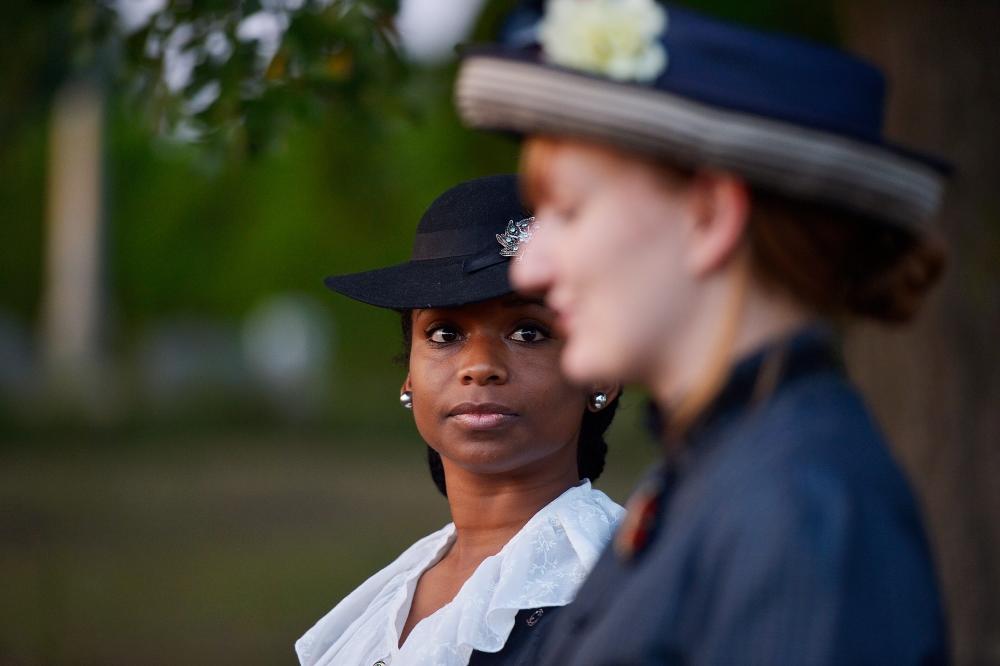
Section Branding
Header Content
Meet Georgia’s Interracial Founding Family
Primary Content

A lot of interesting people are buried in Macon’s Riverside Cemetery (established in 1887), and every year around Halloween volunteers lead tours where some of the permanent residents come alive.
This year’s “Spirits in October” walk highlights Georgia’s surprisingly complex racial history.
On a hill, two young women sit silently on a stone bench surrounded by graves. One woman is black the other is white.
They are approached by a small tour group.
“These visitors and I have come from the year 2013,” the tour guide says to the women.
Minnie Sheftall Lee and Zenobia Sheftall are dead, but they've been brought back by actresses in turn of the 20th century dress.
“A founding settler of Georgia, one of the original 13 colonies, was my ancestor,” says the black woman.
“And mine,” interjects the white woman.
“Our ancestor,” they say in unison.
Benjamin Sheftall was the grandson of one of the first Jews to come to the Georgia Colony in 1733. But his family tree spread much farther than the Jewish community of contemporary Savannah.
Benjamin married outside the faith and had a son with a white Methodist named Rebecca Russell. Their son Mordecai was named for an uncle of Benjamin's.
After Rebecca died, “Benjamin took as his consort a free black woman named Maria, with whom he had a son named Benjamin Jackson Sheftall,” the black actress continues with the story.
And so where once there had been one family, there were now two: black Sheftalls and white Sheftalls.
In the 19th Century, two Sheftall men on opposite sides of the color line picked up stakes and left for Macon where they both established families. Minnie and Zenobia are their daughters.
Here to take in the performance is the very living John Sheftall from Zenobia's side.
“There was a family tradition that we were related, but how and why we had both ended up in Macon, you know, from generations back, that part was completely un-preserved as knowledge,” Sheftall says. “Tonight is sort of a wonderful way for me to resolve this in Macon.”
Also walking the tour is Viveca Jackson of Macon. She descends from Minnie's side, the black Sheftalls. The facts about the white side of her family aren't much of a surprise to her.
“I don’t think we really try to integrate black and white, and I think we should because we’re all related in some way,” Jackson said. “I mean, if you go as far back you’re going to find white relates, you’re going to find black ancestors.”
That was certainly the case in Colonial Georgia, where interracial couplings were common and ran the gamut from rape to love, says University of Georgia historian Claudio Saunt.
“And there’s even quite a bit of evidence now suggesting that these kind of relationships were tolerated to some extent,” Saunt says. “It wasn’t until the abolitionist movement in the 1840s and then especially post-Civil War and the Reconstruction Era where these kinds of relationships really receive the kind of vitriol that we come to think of today.”
At Riverside Cemetery, much of John Sheftall's family is nearby, at peace.
“My parents are gone now, they’re buried here in Riverside, along with all four of my grandparents and many other relatives,” Sheftall says.
But not all of the relatives.
The black Sheftall plot is out of sight and over a hill in Oak Ridge Cemetery. While today's Sheftalls are coming together in life, earlier generations remain segregated in death.
Grant Blankenship reports for The Telegraph of Macon. The Spirits in October tour at Riverside Cemetery runs this Thursday through Sunday.
Corrections: An earlier version of this story confused Benjamin Sheftall with his grandfather of the same name.
Tags: Historic Riverside Cemetery, Adam Ragusea, Grant Blankenship, Colonial Georgia, Interracial
